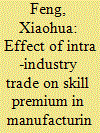| Srl | Item |
| 1 |
ID:
132736


|
|
|
|
|
| Publication |
2014.
|
| Summary/Abstract |
Are preferential trade agreements (PTAs) in the Asia-Pacific region merely a political phenomenon with no economic basis, as some critics say? I challenge this interpretation; in this article I present an explanatory model based on intra-industry trade to indicate what economic interests should drive Japanese and South Korean PTAs with ASEAN partners, and derive specific predictions. An analysis of the actual tariff barrier elimination in the agreements suggests important, but highly specific, economic benefits. First, preference margins are substantively greater for intra-industry trade, and second, intra-industry trade is much less likely to be excluded from tariff reductions when imported into Japan or South Korea. This indicates that PTAs help firms specialize their production throughout the region, and provides an economic rationale for these agreements. A qualitative case study of the Japan-Malaysia PTA and a statistical analysis of tariff liberalization in the PTAs of Japan and South Korea with the ASEAN countries support this view.
|
|
|
|
|
|
|
|
|
|
|
|
|
|
|
|
| 2 |
ID:
161777


|
|
|
|
|
| Summary/Abstract |
In making use of the panel data in 27 manufacturing industries, this paper examines the recent increase in skill premium in China's manufacturing. The paper argues that the recent increase in skill premium in Chinese manufacturing can be partly attributed to the decline in intra-industry trade. A reasonable explanation on this is that the decline in intra-industry trade occurred in the period studied is associated with a decrease in output. This led to a reduction in relative demand of low-skilled workers, which supports the hypothesis of the output-skill substitutability, and finally an increase in skill premium. Further, this paper finds that the negative effect of intra-industry trade on skill premium is larger for high-skilled manufacturing than low-skilled manufacturing. One more result in this paper is that the increase in capital input reduced the skill premium in Chinese manufacturing. The empirical evidence is consistent with a modified model of intra-industry trade with differentiated products and three factor inputs: high-skilled labor, low-skilled labor and capital.
|
|
|
|
|
|
|
|
|
|
|
|
|
|
|
|
| 3 |
ID:
156463


|
|
|
|
|
| Summary/Abstract |
This paper empirically analyzes distinctions between intra- and inter-industry trade indices. The research indicates that the co-movements of business cycles are influenced more through the intra-industry trade channel than by the total volume of trade itself. As trade integration among Asian countries increased, business cycle synchronization among these countries was expected to expand through trade transmission. Inter-industry trade resulting in higher specialization will induce less synchronized business cycles, while intra-industry trade could lead to increased business cycle synchronization. Moreover, I find that increased business cycle synchronization, as one of the optimum currency area criteria, is overemphasized.
|
|
|
|
|
|
|
|
|
|
|
|
|
|
|
|
| 4 |
ID:
160572


|
|
|
|
|
| Summary/Abstract |
This research note presents a new dataset on the speed of tariff liberalization in sixty-one preferential trade agreements (PTAs) signed by fifty states and regional economic organizations over the period 1995 to 2013. We use this dataset to test prominent arguments concerning the impact of intra-industry trade and global value chains on the political economy of trade. Our results indicate that the speed of tariff liberalization through PTAs is considerably faster for intermediate goods than for finished products. This is in line with the most prominent argument about how global value chains affect the political economy of trade liberalization. At the same time, we find mixed evidence for the impact of intra-industry trade on the ease of trade liberalization, which reflects strong cross-country variation. We conclude with a discussion on how the dataset can help tackle important questions in international political economy and inform ongoing debates on trade agreements.
|
|
|
|
|
|
|
|
|
|
|
|
|
|
|
|
| 5 |
ID:
143353


|
|
|
|
|
| Summary/Abstract |
This study examines the bilateral trade relations between New Zealand and India from 1990 to 2014. Using export and import intensity indices and revealed comparative advantage (RCA) indices, it identifies sectors where there is static and dynamic comparative advantage and complementarities. It also examines the extent and movement of intra-industry trade (IIT), using IIT indices, and analyses these indices to consider how trade patterns and relations have changed between 1990 and 2014.
Findings show that trade between New Zealand and India has increased in recent years. The intensity of trade has strengthened, and there has been growth in IIT for a number of industries and product groups. Results also suggest high degree of static and dynamic comparative advantage in a number of product groups. The findings of this study should be relevant to future bilateral trade, economic relations, technology transfer and cultural exchange between New Zealand and India.
|
|
|
|
|
|
|
|
|
|
|
|
|
|
|
|